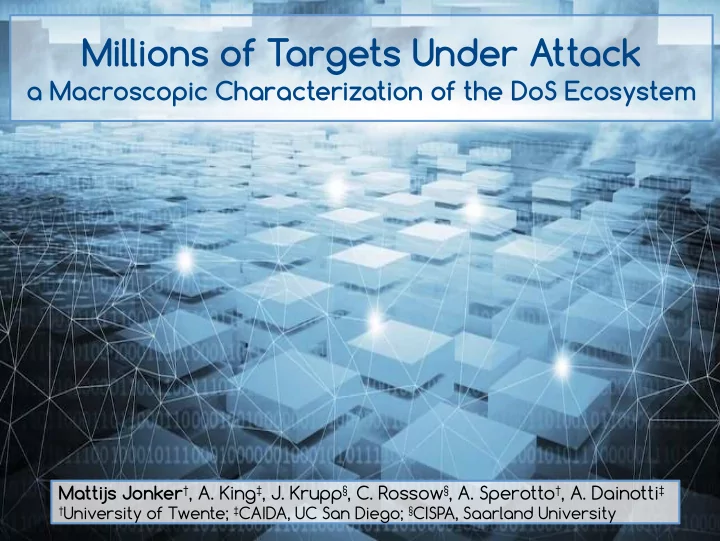

Millions of Targets Under Attack a Macroscopic Characterization of the DoS Ecosystem Mattijs Jonker † , A. King ‡ , J. Krupp § , C. Rossow § , A. Sperotto † , A. Dainotti ‡ † University of Twente; ‡ CAIDA, UC San Diego; § CISPA, Saarland University
Denial-of-Service (DoS) attacks Simple, yet effective class of attacks ● Have gained a lot in popularity over the last years ● Offered “as-a-Service” to the layman for only a few USD ● 2017-11-01 A Macroscopic Characterization of the DoS Ecosystem 2/20
Research goal We aim at presenting a large-scale longitudinal analysis of the DoS ecosystemby means of a macroscopic characterization of attacks, attack targets, and DDoS Protection Services. 2017-11-01 A Macroscopic Characterization of the DoS Ecosystem 3/20
Data sets Four global Internet measurement infrastructures ● – A large network telescope – Logs from amplification honeypots – Data from large-scale, active DNS measurements – A DNS-based data set focusing on DDoS Protection Services (DPS) usage 2017-11-01 A Macroscopic Characterization of the DoS Ecosystem 4/20
UCSD Network Telescope A /8 darknet ● Captures DoS attacks with randomly (and uniformly) spoofed ● IP addresses Captures ~1/256th of IPv4 address space ● Any sizable attack should be visible ● 2017-11-01 A Macroscopic Characterization of the DoS Ecosystem 5/20
UCSD Network Telescope 2017-11-01 A Macroscopic Characterization of the DoS Ecosystem 6/20
Amplification honeypot (AmpPot) Honeypot that mimicks reflectors ● – various protocols (e.g., NTP, DNS, and CharGen) Tries to be appealing to attackers ● – i.e., by offering large amplification Twenty-four AmpPot instances ● – Geographically & logically distributed 2017-11-01 A Macroscopic Characterization of the DoS Ecosystem 7/20
Amplification honeypot (AmpPot) 2017-11-01 A Macroscopic Characterization of the DoS Ecosystem 8/20
Attack events coverage We analyze two years of attack traces ● – March 1, 2015 – Feb 28, 2017 The attacks data sets complement each other: ● – honeypots don’t register randomly spoofed attacks – a darknet doesn’t register reflection attacks 2017-11-01 A Macroscopic Characterization of the DoS Ecosystem 9/20
Attacks analysis source #events #targets #/24s #ASNs UCSD-NT 12.47M 2.45M 0.77M 25990 AmpPot 8.43M 4.18M 1.72M 24432 20.90M 6.34M 2.19M 32580 We observe almost 21 million attacks over 2 years ● – average of 30k daily 2.19 million /24s observed ● This number is about a third of recent estimates of the actively used ● IPv4 address space 1,2 [1] Sebastian Zander et al. Capturing Ghosts: Predicting the Used IPv4 Space by Inferring Unobserved Addresses. In IMC’14. [2] Philipp Richter et al. Beyond Counting: New Perspectives on the Active IPv4 Address Space. In IMC’16. 2017-11-01 A Macroscopic Characterization of the DoS Ecosystem 10/20
Attacks analysis reflector events (%) NTP 40.08 DNS 26.17 IP proto TCP UDP ICMP Other CharGen 22.37 events (%) 79.4 15.9 4.5 0.2 SSDP 8.38 RIPv1 2.27 Other 0.73 NTP is the most-abused protocol in reflection and ● amplification attacks TCP is the most prominent IP proto in randomly spoofed ● attacks 2017-11-01 A Macroscopic Characterization of the DoS Ecosystem 11/20
Attacks analysis service events (%) HTTP 48.68 HTTPS 20.68 MySQL 1.12 DNS 1.07 Other 28.45 We map dst:port in randomly spoofed attacks to services ● using IANA assignments Our results show that almost 70% (potentially) target Web ● infrastructure 2017-11-01 A Macroscopic Characterization of the DoS Ecosystem 12/20
Active DNS measurement data Third data set: active DNS measurments ● Contains, among others, A records (i.e., IPv4 address) ● – allows historical address lookups We use data for all domains under .com, .net, and .org ● – Together comprise ~50% of global DNS namespace 2017-11-01 A Macroscopic Characterization of the DoS Ecosystem 13/20
Active DNS measurement data Used to map IP addresses to Web sites ● We consider the presence of a www. in the DNS a Web site ● – We find 210 million such Web sites over two years start end zone #Web sites .com 173.7M .net 21.6M 2015-03-01 2017-02-28 .org 14.7M 210.0M 2017-11-01 A Macroscopic Characterization of the DoS Ecosystem 14/20
Attacks Web site association over time 572k of 6.34M target IPs host 1 or more Web site ● 134M Web sites associated with attacks over 2y ● – That is 64% of the overall 210M observed – average is ~4M daily (3%) Peaks correspond to large hosters under attack ● – up to 15M Web sites associated 2017-11-01 A Macroscopic Characterization of the DoS Ecosystem 15/20
Use of DDoS Protection Services (DPS) We study if attacks on Web sites affect DPS migration ● DPS are commercial, cloud-based mitigation services ● We cover 9 leading commercial providers: ● – Akamai, CenturyLink, CloudFlare, DOSArrest, F5, Incapsula, L3, Neustar & Verisign … and one smaller DPS: ● – VirtualRoad – protects freedom of speech organizations 33 million Web sites (24.6% of attacked Web sites) ● 2017-11-01 A Macroscopic Characterization of the DoS Ecosystem 16/20
Classification of Web sites 2017-11-01 A Macroscopic Characterization of the DoS Ecosystem 17/20
Migration delay Earlier migration follows attacks of higher intensity 2017-11-01 A Macroscopic Characterization of the DoS Ecosystem 18/20
Conclusions Proved the potential of large-scale longitudinal ● characterization of the DoS ecosystem – A third of actively used /24s under attack – A prevalence towards attacks that target Web infrastructure port – About two thirds of Web sites involved in attacks – A correlation between attack intensity and DPS migration 2017-11-01 A Macroscopic Characterization of the DoS Ecosystem 19/20
Questions? Mattijs Jonker m.jonker@utwente.nl 2017-11-01 A Macroscopic Characterization of the DoS Ecosystem 20/20
Recommend
More recommend